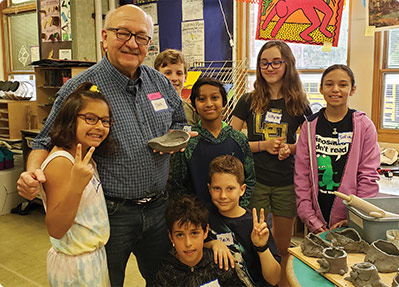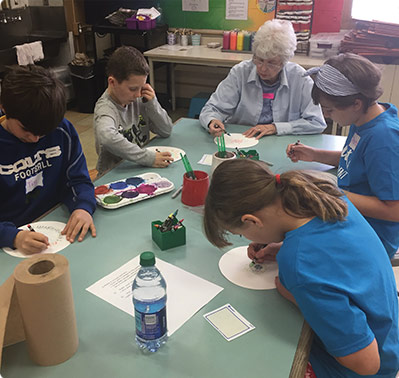
Double Your Impact for the Holidays
Double Your Impact for the Holidays
Your urgently needed year-end gift can go twice as far to provide care and support and accelerate Alzheimer's research this holiday season — and all year long. Show your giving spirit today during this 2x Match Challenge.
Donate NowCreating and Connecting Through Art
Kids, People Living With Dementia Learn From Each Other
Kids, people living with dementia learn from each other
Chuck Costakos didn’t start out as an art connoisseur, but his insatiable curiosity led him to volunteer as a docent for the Columbus Museum of Art. For 10 years, the retired grandfather immersed himself in his role as a guide. He shared his knowledge with children on school field trips as well as adults living with dementia through a special program hosted by the museum.
Things changed when Sandy, Chuck’s wife of 25 years, began to notice shifts in his demeanor. “He was more forgetful,” she says. “He had a hard time completing projects, and he showed less interest in cooking with me, which is something we always did together.”
In 2017, Chuck was diagnosed with Alzheimer’s disease, and he made the difficult decision to give up volunteering at the museum. “I sort of retreated a little bit, kept to myself more,” he says.
The Alzheimer’s Association Central Ohio Chapter encouraged Chuck to find a new way to explore his creativity and love of art. He began taking group art classes for individuals living with Alzheimer’s, and while he didn’t have experience painting, drawing or sculpting, he was eager for the challenge. “I like trying things that make you wonder a little bit,” Chuck says.
 Soon, Chuck was invited to participate in Art & Alzheimer’s, a partnership between the chapter and Wickliffe Progressive Elementary School in Upper Arlington, Ohio. Once a week, 20 fourth-grade students and four adults living with dementia teamed up to make art and build new friendships.
Soon, Chuck was invited to participate in Art & Alzheimer’s, a partnership between the chapter and Wickliffe Progressive Elementary School in Upper Arlington, Ohio. Once a week, 20 fourth-grade students and four adults living with dementia teamed up to make art and build new friendships.
The school’s art teacher, Lindsay Bennett, worked closely with the chapter to develop a program that was fulfilling to her multigenerational classroom. She assigned projects that used simple materials and fostered collaboration, like collages and ceramics.
As the program progressed, it became clear that the social and emotional benefits were invaluable and mutually shared. “The adults really enjoyed talking with the kids, it brought back memories from when they were in school,” Lindsay says. “It was way more about the conversations and relationships than the actual art.”
Benefits of expression
For individuals living with Alzheimer’s, there are many reasons to take up art: Tapping into their creativity can help build self-esteem and reduce stress, while providing a space to express themselves.
“The experience of having dementia can be extremely frustrating and it can bring up a lot of emotions, both positive and negative,” says Deborah DelSignore, M.A., ATR-BC, an adjunct associate professor of art therapy at the School of the Art Institute of Chicago. “Through the art-making process, there’s an opportunity to communicate and release those thoughts and feelings.”
The power of art and music
Art and music can enrich the lives of people living with Alzheimer's. They allow for self-expression and engagement, even as the disease progresses.
The most valuable benefits for many, though, are the connections they make with the materials and the people involved. “Because art has the potential to stimulate so many of our senses, being creative can remind people about the world around them,” DelSignore says.
Renewed purpose and community
 The relationships formed in the Art & Alzheimer’s classroom have had a lasting impact on everyone involved.
The relationships formed in the Art & Alzheimer’s classroom have had a lasting impact on everyone involved.
“[The children] ended up learning just as much from the adults as the adults learned from them,” Lindsay says.
An energetic student named GG was particularly curious about Chuck’s extensive travels. “When she found out I had been to Russia, GG was so excited — she jumped up and down and gave me a big hug,” he says. “It turns out she was born in Russia and had been adopted by an American family.”
Sandy noticed the positive impact the interactions had on Chuck. “He was really bubbly after the classes, it was a happy experience,” she says. “We’d come out of class and talk about GG and what they did that day. He enjoyed every minute of it.”
For Chuck, art gave him renewed purpose and community in the wake of Alzheimer’s, and he hopes to participate again in the Art & Alzheimer’s program. “I like it because you get out and meet some people and you can actually make a contribution,” Chuck says.
